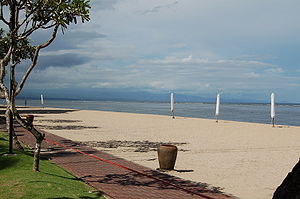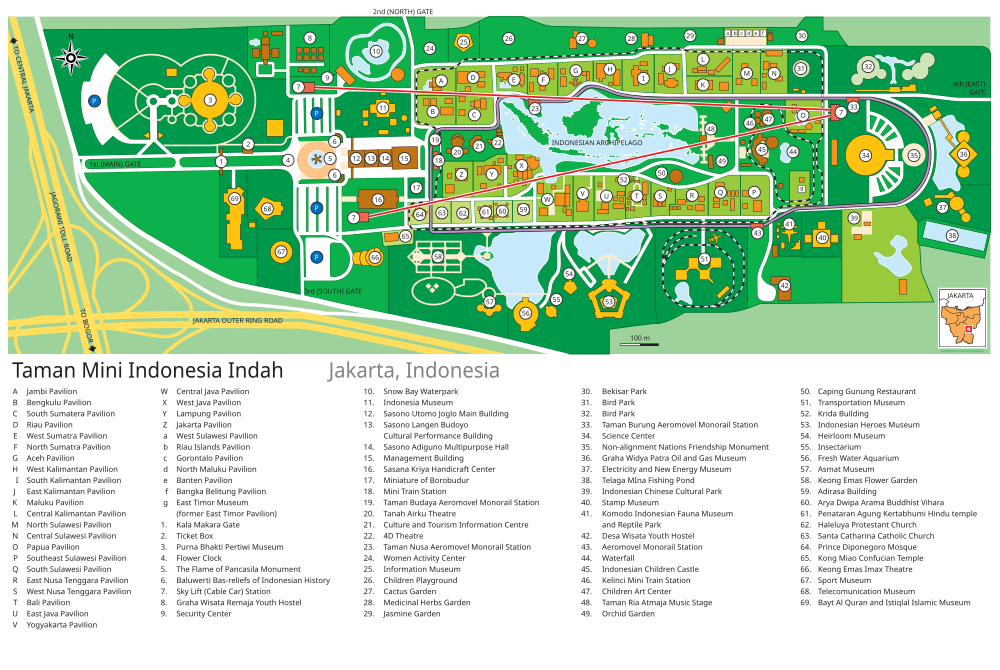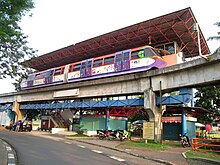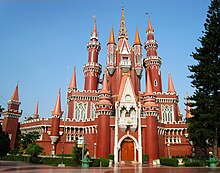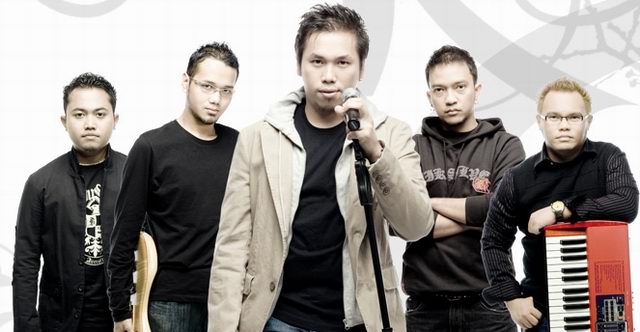Senin, 13 Maret 2017
Sanur Beach, Bali
Sanur (Indonesian:Pantai Sanur, pronounced sah-noor) is a coastal stretch of beach of Denpasar city of southeast Bali, about 30 minutes drive from Ngurah Rai International Airport, which has grown into a little town in its own right. A 5.1 kilometer area of Sanur's coastline, from Matahari Terbit Beach to Mertasari Beach, was reclaimed in 2008.[1]
In 1906 the northern part of Sanur beach was used as the landing site for the Dutch invasion troops during the intervention in Bali. During World War II, Sanur was again the entry point through which the Japanese forces landed to occupy the island of Bali.
Bali Beach Hotel in Sanur was built by Sukarno president in 1963, and boosted tourism in Bali. Prior to it only three hotels existed on the island.[2] Construction of hotels and restaurants began to spread throughout Bali.
Today Sanur contains a number of hotel resorts such as the Fairmont Sanur Beach Bali and Bali Hyatt (currently under renovation and not to be confused with the Grand Hyatt in Nusa Dua). Sanur is also home to a growing number of popular villa resorts, such as The Zen Villas.
Traditional fishing boats can be seen on the beach of Sanur offering a scenic view of the island Nusa Penida.
Adrien Jean Le Mayeur de Merpes (1880-1958), a Belgian painter, lived in Sanur from 1932 - 1958. His house was transformed into a museum, Museum Le Mayeur, where about 80 of his most important paintings are exhibited.[3] Bali Orchid Garden, a park about 3 km north of Sanur is worth a visit as well.[4]
Another interesting sight can be visited in the south of Sanur in Jalan Danau Poso Street beside Pura Blanjong, a small Hindu temple. A stone column measuring 1.77 metres can be seen under a roof at the end of a small and short blind alley. This is the oldest object produced by men on Bali. The column bears inscriptions dating from the 9th century written in Sanskrit and in a very old form of Balinese.[5] Various objects made of stone possibly dating from the same period are exhibited as well.
Taman Mini Indonesia Indah
Taman Mini Indonesia Indah (TMII) or "Beautiful Indonesia Miniature Park" (literally translated) is a culture-based recreational area located in East Jakarta, Indonesia. It has an area of about 250 acres (1.0 km2). The park is a synopsis of Indonesian culture, with virtually all aspects of daily life in Indonesia's 26 (in 1975) provinces encapsulated in separate pavilions with the collections of Indonesian architecture, clothing, dances and traditions are all depicted impeccably. Apart from that, there is a lake with a miniature of the archipelago in the middle of it, cable cars, museums, Keong Emas Imax cinema, a theater called the Theatre of My Homeland (Theater Tanah Airku) and other recreational facilities which make TMII one of the most popular tourist destinations in the city.[1]
Since 2007 Taman Mini Indonesia Indah launched new logo with branding slogan Pesona Indonesia ("Indonesian Charm").
On December 31, 2014 World Peace Committee decided TMII as International Civilization Park and World Peace Theme Park.[2]
The idea of presenting Indonesia in a small scale was conceived by former Indonesian first lady, Siti Hartinah, better known as Tien Suharto. It came about at a convention on 8 Cendana Street at March 13, 1970. Through this recreational site, she hoped to cultivate national pride in more Indonesian people.[1] A project called "Indonesian Miniature Project" was started by Harapan Kita Foundation in 1972. The concept of this culture-based recreational area was inspired by Indonesia's unparalleled natural riches and local folk diversity.
TMII was originally located on a public area of 145 ha, as farms and fields. Later, the team was able to convert these fields into a suitable location for the construction. The topography of TMII is rather hilly, consistent with what the builders required. The team claimed the advantage of utilizing this uneven terrain was the ability to create interesting and diverse landscapes and enclosures, as well as reflecting the various characteristics of the Indonesian environment.[1]
PARTS OF TMII
Since each Indonesian province maintains its own unique and distinct cultures, shelters, attire and dialects, TMII built a model of each of the houses from Indonesian provinces. TMII attempted not only to reconstruct the homes of the various provinces, but also to create a realistic model of the environment and shelters of the various people of Indonesia.[3] The venues, which are situated around the main lake in a similar fashion to the different islands of the Indonesian archipelago, are thematically divided into six areas in respect to the main islands of Indonesia; Java, Sumatra, Kalimantan (Borneo), Sulawesi, the Lesser Sunda Islands, Maluku and Papua. Each pavilions featured in typical vernacular Indonesian architecture of each provinces. Examples of Indonesian traditional vernacular houses are: Joglo and Omah Kudus Javanese houses of Central Java and Yogyakarta pavilion; Minang Rumah Gadang of West Sumatra pavilion; Malay houses of Jambi and Riau provinces; Torajan Tongkonan and Bugis house of South Sulawesi pavilion; and Balinese house compound with intricately carved Candi Bentar split gate and Kori Agung gate.
It also displays various traditional costumes, wedding costumes, dance costumes, also ethnography artifacts such as weapons and daily tools, models of traditional architecture are in display to describes the way of life of its people. Each provinces pavilions also equipped with small stage, amphitheatre or auditorium for traditional dance performances, traditional music performances or traditional ceremonies that usually held in Sundays. Some of these pavilions also equipped with cafeterias featuring traditional Indonesian cuisines and also souvenir shops offering various handicrafts, T-shirts and souvenirs.
Since 1975 until the 2000s, the original design of TMII consist of a model of the houses from the 27 provinces of Indonesia, including East Timor. But after the secession of East Timor from Indonesia in 2002, the East Timor pavilion changed its status to become the Museum of East Timor. Also since Indonesia now consist of 33 provinces, currently the new province pavilions of Bangka Belitung, Banten, West Sulawesi, North Maluku, Gorontalo, Riau Islands, and West Papua is being built in northeast part of the park.
After the recognition of Indonesian Chinese culture as the integral part of Indonesian culture in 2000, the new Indonesian Chinese pavilion and a Confucian temple was built within the park.
Religious Buildings
The religious buildings of several official faiths is meant to showcase the inter-faiths tolerance and religious harmony of Indonesia. The religious buildings are:- Pangeran Diponegoro Mosque
- Santa Catharina Catholic church
- Haleluya Protestant church
- Penataran Agung Kertabhumi Balinese Hindu temple
- Arya Dwipa Arama Buddhist temple
- Sasana Adirasa Pangeran Samber Nyawa
- Kong Miao Confucian temple
Gardens and Parks
There are about ten gardens spread within TMII complex, but most are located primarily on the north and northeast side of the main lake:- Orchid Garden
- Medicinal herbs Garden
- Cactus Garden
- Jasmine Garden
- Keong Emas (Golden Snail) Flower Garden
- Fresh Water Aquarium
- Bekisar (a type of rooster) Garden
- Bird Park
- Taman Ria Atmaja Park, stage and music performances
- Taman Budaya Tionghoa Indonesia, an Indonesian Chinese cultural park (under construction)
- Reptile Park in Komodo Zoological Museum compound. A fully grown Komodo dragon (Varanus komodoensis) nicknamed Bima resides in the reptile park near the eastern gate, which you can pet and take pictures with for Rp.5,000 ($0.60).[4]
Technological Centre
Pusat peragaan Iptek or Science and Technology Display Centre is under coordination of Research and Technology Ministry. At the end of 2011 has 15 sites with about 300 science tools and visited by 341,000 visitor in a year. The sites are Robotic, Electric and Magnet, Mechanics, Mathematics, etc.[5]Museums
There are fourteen museums at TMII:- Indonesia Museum
- Purna Bhakti Pertiwi Museum
- Soldier Museum
- Indonesian stamps Museum
- Pusaka (Heirloom) Museum
- Transportation Museum
- Museum Electricity & New Energy Museum
- Telecommunication Museum
- Penerangan Museum
- Sports Museum
- Asmat Museum
- Komodo Zoological Museum and Reptile Park
- Insects Museum
- Research & Technology Information Centre
- Oil & Gas Museum
- East Timor Museum (former East Timor province pavilion)
Theatres
- Keong Emas (Golden Snail) Imax Theater
- Tanah Airku Theater
- 4D Theater
Monuments, Halls, Buildings and other Exhibits
Kala Makara main entrance
Sasono Utomo main building
- Kala Makara main gates
- Flower clock
- Tugu Api Pancasila, the main monument, an obelisk celebrating Pancasila
- Baluwerti, a twin gate with relief of Indonesian history on its wall
- Pendopo Agung Sasono Utomo (Grand Hall), the main building in Javanese Joglo style
- Sasono Utomo, exhibition hall
- Sasono Langen Budoyo, indoor stage and theater
- Sasono Manganti
- Sasana Kriya, multi purpose function hall
- Park Management Office
- Cokot Sculpture, a display of wooden sculptures by Cokot, a famous Balinese artist
- The Miniature of Borobudur
- APEC Memorial Monument and Garden
- Non Alignment Nations Friendship Monument and Garden
- The Miniature of Indonesian Archipelago on central lake
- Indonesian Archipelago Plaza and Stage
- Jati Taminah, a remnant of a large teak tree
- Kayu Gede (large wood), the display of large tree trunk
Rides
Wind powered Aeromovel people mover ride around the park.
- Skylift Indonesia cable car
- Aeromovel Indonesia, a wind powered people mover
- Mini train around the park
- Boat ride on Indonesian archipelago lake
- Swan paddle boat on Indonesian archipelago lake
- Bicycle rent ride
- Car ride around the area
Recreation facilities
Istana Anak-anak Indonesia.
- Istana Anak-Anak Indonesia (The Castle of Indonesian Children)
- Taman Among Putro kiddy rides park
- Desa Seni dan Kerajinan handicraft center
- Rare books market
- Snowbay Waterpark swimmingpool
- Telaga Mina fishing pond
- Warna Alam outbound camp
Lodgings
- Desa Wisata hostel
- Graha Wisata Remaja youth hostel
Restaurants
- Caping Gunung restaurant
- California fried chicken restaurants
- Pecel Madiun restaurant
- Various cafetarias and warungs available throughout the park featuring Indonesian cuisines such as soto, gado-gado, nasi goreng and satay.
Plans
As of 2011 the operator planned to disburse $35 million for building a new Discovery World theme park. A 2-hectare area was to be built and it was predicted to be operated before the end of 2012. It would serve 100 venues/rides and was predicted to attract 1.2 million visitors from Indonesia and Southeast Asia.Boxing
Boxing is a combat sport in which two people wearing protective gloves throw punches at each other for a predetermined set of time in a boxing ring.
Amateur boxing is both an Olympic and Commonwealth Games sport and is a common fixture in most international games—it also has its own World Championships. Boxing is supervised by a referee over a series of one- to three-minute intervals called rounds. The result is decided when an opponent is deemed incapable to continue by a referee, is disqualified for breaking a rule, resigns by throwing in a towel, or is pronounced the winner or loser based on the judges' scorecards at the end of the contest. In the event that both fighters gain equal scores from the judges, the fight is considered a draw (professional boxing). In Olympic boxing, due to the fact that a winner must be declared, in the case of a draw - the judges use technical criteria to choose the most deserving winner of the bout.
While people have fought in hand-to-hand combat since before the dawn of history, the origin of boxing as an organized sport may be its acceptance by the ancient Greeks as an Olympic game in BC 688. Boxing evolved from 16th- and 18th-century prizefights, largely in Great Britain, to the forerunner of modern boxing in the mid-19th century, again initially in Great Britain and later in the United States.
Basketball
Basketball is a non-contact team sport played on a on a rectangular court by two teams of five players each. The objective is to shoot a ball through a hoop 18 inches (46 cm) in diameter and 10 feet (3.048 m) high that is mounted to a backboard at each end of the court. The game was invented in 1891 by Dr. James Naismith, who would be the first basketball coach of the Kansas Jayhawks, one of the most successful programs in the game's history.
A team can score a field goal by shooting the ball through the basket being defended by the opposition team during regular play. A field goal scores three points for the shooting team if the player shoots from behind the three-point line, and two points if shot from in front of the line. A team can also score via free throws, which are worth one point, after the other team is assessed with certain fouls. The team with the most points at the end of the game wins, but additional time (overtime) is mandated when the score is tied at the end of regulation. The ball can be advanced on the court by passing it to a teammate, or by bouncing it while walking or running (dribbling). It is a violation to lift, or drag, one's pivot foot without dribbling the ball, to carry it, or to hold the ball with both hands then resume dribbling.
The game has many individual techniques for displaying skill—ball-handling, shooting, passing, dribbling, dunking, shot-blocking, and rebounding. Basketball teams generally have player positions, the tallest and strongest members of a team are called a center or power forward, while slightly shorter and more agile players are called small forward, and the shortest players or those who possess the best ball handling skills are called a point guard or shooting guard. The point guard directs the on court action of the team, implementing the coach's game plan, and managing the execution of offensive and defensive plays (player positioning).
Basketball is one of the world's most popular and widely viewed sports.[1] The National Basketball Association (NBA) is the most popular and widely considered to be the highest level of professional basketball in the world and NBA players are the world's best paid athletes by average annual salary per player.[2][3] Outside North America, the top clubs from national leagues qualify to continental championships such as the Euroleague and FIBA Americas League. The FIBA Basketball World Cup attracts the top national teams from around the world. Each continent hosts regional competitions for national teams, like EuroBasket and FIBA Americas Championship.
The FIBA Women's Basketball World Cup features the top national women's basketball teams from continental championships. The main North American league is the WNBA, whereas the EuroLeague Women has been dominated by teams from the Russian Women's Basketball Premier League.
Kerispatih
Kerispatih formed on 21 April 2003 on the initiative of four students Musicians Institute Indonesia, Arief, Hurricane, Andika, and Anton. Initially, they formed a band themed instrumental ethnicity, which they composed in the new arrangement. The first appearance in the event they are Farabi Sunday 22 April 2003. So they recruited Sammy, their colleagues on campus, which is one of the top 30 finalists of Indonesian Idol I / 2004, as a vocalist.
Before Kerispatih formed, the storm also had to make an album C4U and also jointly serve in the band spiritually Joyfull Ministry together: Robert Ludji (keyboard synthesizer & Electric Guitar) John Setiabudi (Bass), Ongen Ririhena (Drums) & Eric Bastian (Keyboard) Hurricane (Lead Keyboard). Joyfull own band often perform mission trip to several cities in Indonesia at the end of the era of 99 to 2001
Professional careers they lead after forming the band's management, which was then governed by Ingga Jaya Purda. Kerispatih now incorporated in the management Bagot'z Production. Kerispatih started recording in 2004. They were joined in a project titled Gulalikustik compilation album (released September 2004), with a major label Nagaswara. Their participation on this album came from an event organized by a Private Radio Stations (88.00 Mustang FM) named Cotton candy (Songs Gue Cendili), which is a forum for creators and a new band Indonesia. Tit for tat, the Mustang offers Kerispatih in the Kolabirasi project. In the album they contributed two songs, "Forget Me" and "A kind of Hearts for Love".In 2005, Kerispatih released their first album titled Heart Honesty. Singles were released on the album include: "Honesty Heart", "Love White", and "Song of Longing". The album received Platinum Awards in 2006. Their success is evidenced also by honored as Newcomer Greatest Hits album in the arena of SCTV Music Awards 2006. [1]In 2007, Kerispatih issued a second album titled Reality feelings, and released his first single on the album is titled "Mengenangmu", and Indonesia dominate the charts and radio. After the success of "Mengenangmu", Kerispatih released a second single titled "But Not Me" which according to predictions will repeat the success of "Mengenangmu". They then released the third single titled "All Ages" and "For the First Time" as the fourth single. As with their first album, this album also successfully received Platinum Awards in 2007.Kerispatih also participated in the debut album President of the Republic of Indonesia to 6, Susilo Bambang Yudhoyono, to sing a song written by SBY titled "Silence". [2]In June 2008, Kerispatih released her third album titled "Enduring By Time". In this third album, the majority of songs composed and composed by storm, keyboardist Kerispatih. The storm also say that this album is the coalescence of the first album and their second album. So, on this third album the most perfect impression of the three albums that have been released. In the album Enduring By this time, Kerispatih chose the song "When this Rasaku Tua Goliath" became their first single on this third album.At the end of 2009, Kerispatih released his fourth album titled "All About Love". The main song of the fourth album is "I Gotta be honest". In early 2010, Kerispatih successfully held its first overseas concert in Hong Kong.On February 2, 2010, one of the personnel Kerispatih, Sammy, had to return to deal with the police, whereas before Sammy was reported to be stealing cars Honda Civic, which at that time Sammy involved with drugs which made him fired from Kerispatih, and Kerispatih immediately find a new vocalist for fill the void that has been left vocalist Sammy because of drugs. Finally, Fandy Santoso (rank 5 Indonesian Idol finalist IV / 2007) was elected as the new lead singer Sammy replaces.
Whitney Houston
Whitney Elizabeth Houston (August 9, 1963 – February 11, 2012) was an American singer, actress, producer, and model. In 2009, Guinness World Records cited her as the most awarded female act of all time.[1] Houston is one of pop music's best-selling music artists of all-time, with an estimated 170–200 million records sold worldwide.[2][3] She released seven studio albums and two soundtrack albums, all of which have diamond, multi-platinum, platinum or gold certification. Houston's crossover appeal on the popular music charts, as well as her prominence on MTV, starting with her video for "How Will I Know",[4] influenced several African American women artists who follow in her footsteps.[5][6]
Houston is the only artist to chart seven consecutive No. 1 Billboard Hot 100 hits. She is the second artist behind Elton John and the only woman to have two number-one Billboard 200 Album awards (formerly "Top Pop Albums") on the Billboard magazine year-end charts.[7] Houston's debut album, Whitney Houston (1985), became the best-selling debut album by a woman in history.[8] Rolling Stone named it the best album of 1986, and ranked it at number 254 on the magazine's list of the 500 Greatest Albums of All Time.[8] Her second studio album, Whitney (1987), became the first album by a woman to debut at number one on the Billboard 200 albums chart.[8]
Houston's first acting role was as the star of the feature film The Bodyguard (1992). The film's original soundtrack won the 1994 Grammy Award for Album of the Year. Its lead single, "I Will Always Love You", won the Grammy Award for Record of the Year and became the best-selling single by a woman in music history. With the album, Houston became the first act (solo or group, male or female) to sell more than a million copies of an album within a single week period under Nielsen SoundScan system.[8] The album makes her the top female act in the top 10 list of the best-selling albums of all time, at number four. Houston continued to star in movies and contribute to their soundtracks, including the films Waiting to Exhale (1995) and The Preacher's Wife (1996). The Preacher's Wife soundtrack became the best-selling gospel album in history.[9]
On February 11, 2012, Houston was found dead in her guest room at the Beverly Hilton, in Beverly Hills, California. The official coroner's report showed that she had accidentally drowned in the bathtub, with heart disease and cocaine use listed as contributing factors.[10] News of her death coincided with the 2012 Grammy Awards and featured prominently in American and international media.
Senin, 06 Maret 2017
A Trip to Borobudur Temple
Three years ago, I and my classmates
visited Borobudur Temple. We went to Borobudur temple by bus. We left our
school at nine o’clock. It took us 24 hours to arrive there. I arrived there
nine o’clock the next day. Along the road, we saw many vehicles, unique houses,
prominent buildings, and some other tourists.
After we arrived at the Borobudur
temple, one of my teachers went to buy tickets. After we waited him for a
moment we entered into Borobudur temple area. Then we went up to the top of the
temple. Borobudur temple was built at Budur Village, Magelang, Jawa Tengah by
Syailendra Dynasty. Borobudur Temple is the biggest temple in the world. It has
504 statues and 1.400 reliefs. From the top of the temple we can
see such beautiful scenery. I and my friends went around
the temple together. Finally, after having some visits, we should go to the
hotel to stay and continue our study tour the next day.
We felt tired that day but we felt so
happy to visit Borobudur temple which is well-known as one of the greatest
legacies Indonesia has ever had. I hope the temple can be loved by all of the
visitors and the government.
Langganan:
Postingan (Atom)
